Believe me, that's the first thing I tried, the second was stereo! The didn't seem to have much sound or change much except the background noise.Beethoven's ear trumpets from the pre-electronic era:
The only audio the horn has been used for is talking thru it and playing a cellphone thru it. It again seems to have no particular sound.
I did that with an all hex cell version, basically cutting the walls to make a spherical mouth of the same radius as the length of the horn. I think it's a good option and not too hard to do, though it does cut back the outer wall a good bit. Is that a better way to make it than the soccer shape? I don't know.shorten the walls that form the outer perimeter to get the soccer ball exit.
@Hearinspace I think this is what you are thinking of, all hexagonal and with straight cells. This is a first look. This is made with the mouth in a spherical shape. Normally hexagons (and squares) don't fit like this, they want to be flat or have spaces between the cells. But I managed to get the walls to all touch, no gaps between them.


I have been test printing with wood filled filament, and the results are promising. It isn’t easy to print, but I have now found some good settings. Normally the color is very uniform, but I have the start of a Python script which will vary the color, giving it more of a grain. Still working on a better looking grain.
The filament is ~30% wood dust, in this case walnut. It does smell like walnut sawdust when printing. 🙂 The feel and the sound of it are noticeably different than regular PLA or PETG plastic and it may have acoustic advantages over the more homogenous materials. At least that’s my hope.
The filament is ~30% wood dust, in this case walnut. It does smell like walnut sawdust when printing. 🙂 The feel and the sound of it are noticeably different than regular PLA or PETG plastic and it may have acoustic advantages over the more homogenous materials. At least that’s my hope.
Attachments
If the sub-horns are exponential, might their narrowing directivities at high frequencies yield a directivity pattern that looks a bit spikey in the high treble?

Perhaps that’s already taken into account and I missed it.
Few
Perhaps that’s already taken into account and I missed it.
Few
That’s the flawed idea of multicell horns. But the power response is not spiky like our friend shown above.
Each cell will beam at HF, but those beams overlap making a sonically smooth response. The cells aren’t laser beams at HF, they spread and blend.
By contrast, most other horns beam, but there isn’t good way to spread around that HF. There is just one lonely HF beam with no friends to play with - no team work.
Each cell will beam at HF, but those beams overlap making a sonically smooth response. The cells aren’t laser beams at HF, they spread and blend.
By contrast, most other horns beam, but there isn’t good way to spread around that HF. There is just one lonely HF beam with no friends to play with - no team work.
I’m new to multicellular horns, so I mean no offense. I’m just trying to learn. The spikes need to be broad enough to constructively overlap and create smooth directivity, correct? If they’re too narrow they won’t sum to a smooth and uniform directivity. So I’m just trying to learn how the spikiness can be avoided; I’m not implying it can’t be avoided.
Few
Few
No offense taken! It’s just a common misunderstanding of multi- cell horns. You will find it as an objection all over the interwebs. I see it as an imaginary fault, based on looks, not sound.
You are correct, the “spikes” or polar patterns at HF are wide enough that they overlap and blend together, at least up to 20 kHz and beyond, depending on the horn. If the cells were huge and/or widely spaced then the HF would not overlap and the result might look like an hedgehog or echidna bristle.
Fortunately at the sizes we tend to use, that’s not a problem. As the horns get larger more cells can be used to keep the HF polar response smooth. The most I have ever seen is 24 cells.
You are correct, the “spikes” or polar patterns at HF are wide enough that they overlap and blend together, at least up to 20 kHz and beyond, depending on the horn. If the cells were huge and/or widely spaced then the HF would not overlap and the result might look like an hedgehog or echidna bristle.
Fortunately at the sizes we tend to use, that’s not a problem. As the horns get larger more cells can be used to keep the HF polar response smooth. The most I have ever seen is 24 cells.
https://sciencedemonstrations.fas.harvard.edu/presentations/acoustic-horn
Eric Heller (who is mentioned here) is a real big- shot in chemistry and physics. It’s fun to see him weighing in on audio, especially in such a relevant way.
Eric Heller (who is mentioned here) is a real big- shot in chemistry and physics. It’s fun to see him weighing in on audio, especially in such a relevant way.
- Home
- Loudspeakers
- Multi-Way
- A different sort of Multi-Cell horn. 3D printing.
